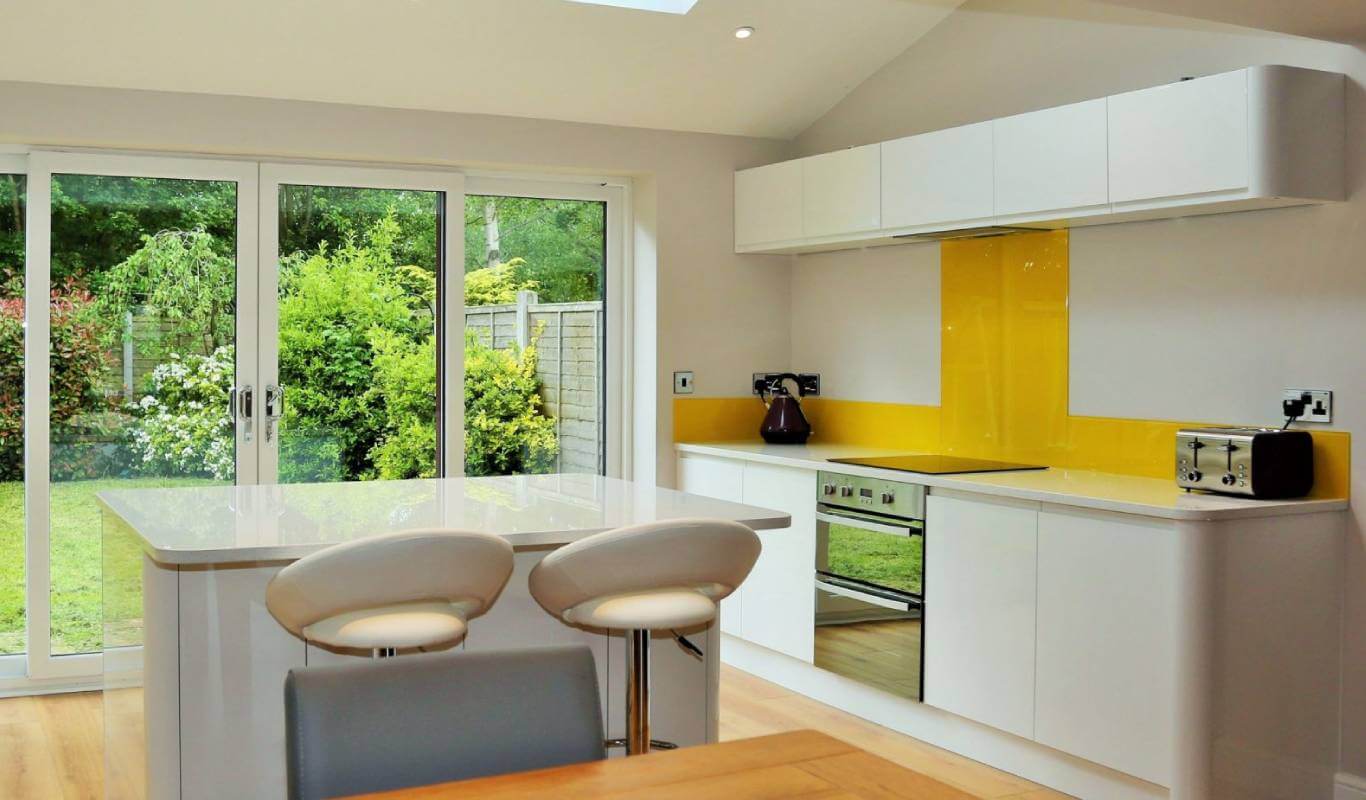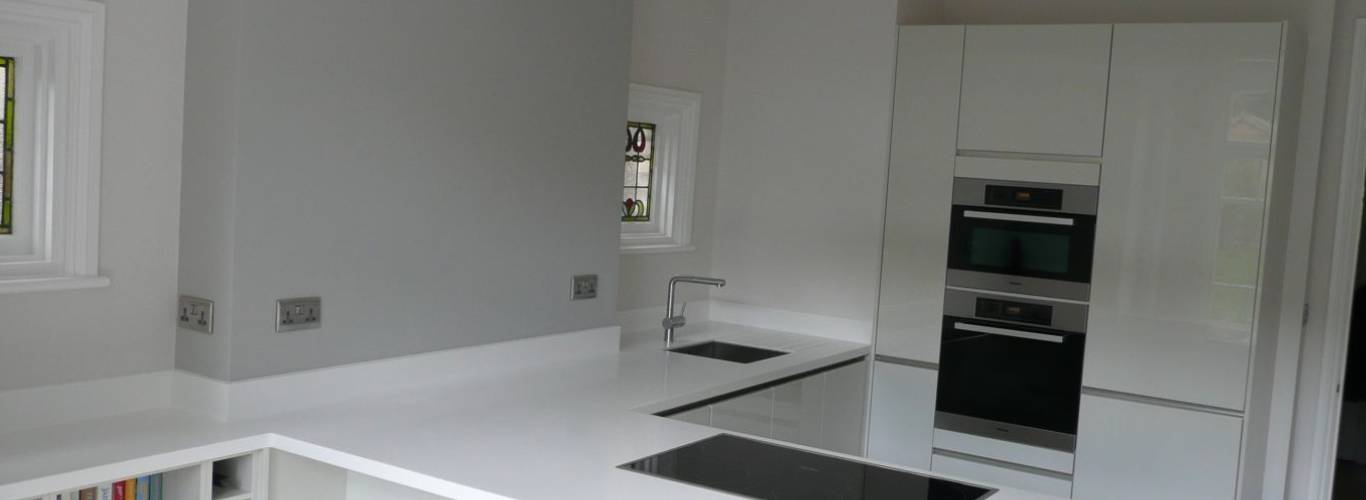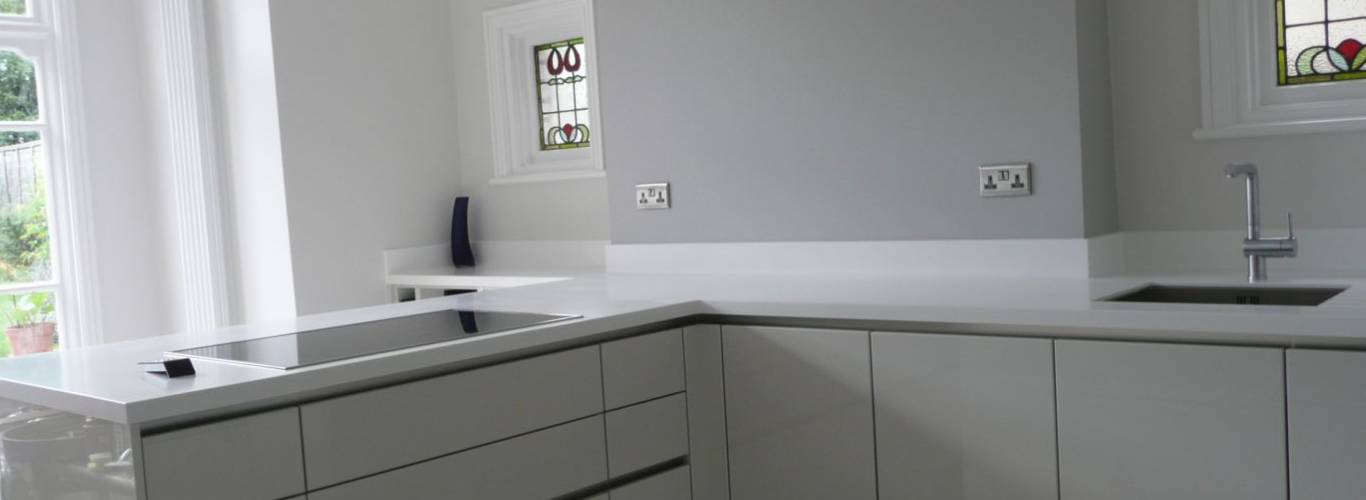Need Assistance?
If you have any question feel free to contact us!

When it comes to designing your kitchen, every detail matters. From choosing the right countertops to selecting the perfect appliances, each decision contributes to your space’s overall functionality and style. One often overlooked element crucial in practicality and aesthetics is the choice between upstands and splashbacks. Therefore, in this blog, we will learn the features and benefits of upstands and splashbacks to assist you in making a feasible decision about your kitchen renovation.
An upstand is a vertical strip of material, typically made from the same material as your kitchen worktop, which is placed upright at the back of the worktop against the wall. Upstands range from 60-150mm in height to 20mm in thickness and serve multiple purposes in your kitchen. Let’s take a look at how they are beneficial:
Creating a Seal and Preventing Mess: One of the primary functions of an upstand is to build a seal between the worktop and the wall, ensuring that liquids or crumbs do not fall behind the cabinets. Upstands help maintain cleanliness and make cleaning up spills or messes easier by acting as a barrier.
Enhancing the Finish: Besides its practical role, an upstand contributes to your kitchen’s overall aesthetic appeal. It provides a neater finish against the wall, especially if it is not perfectly straight or has small expansion gaps in the worktop.
Protection and Easy Maintenance: Upstands act as a shield, ensuring the wall remains free from stains and damage caused by water or cooking residues. Furthermore, upstands are much easier to wipe down and maintain than the wall, reducing the effort required to keep your kitchen clean.
Flexibility and Design Options: They are typically made from the worktop material to give a cohesive and harmonious look throughout your kitchen. Whether you choose a matching or contrasting material, upstands give you the freedom to customise the appearance of your kitchen space according to your style and preferences.
Hygienic Solution: By creating a seal between the worktop and the wall, upstands help maintain a hygienic kitchen environment. The tight seal prevents the accumulation of dirt, grime, and food particles in hard-to-reach areas, reducing the risk of bacterial growth.
Durability and Longevity: Upstands are typically made from high-quality materials known for their durability and longevity. Whether you choose materials like quartz, granite, or solid surface, upstands are designed to withstand daily wear and tear.
Improved Resale Value: Investing in upstands as part of your kitchen renovation enhances the resale value of your home. Potential buyers appreciate the attention to detail, and the added functionality upstands provide.
Versatile Design Element: Upstands are not limited to just kitchens. They can be utilised in other areas of your home where countertops are present, such as bathrooms, laundry rooms, or utility spaces. The versatility of upstands allows you to create a cohesive design theme throughout your home, ensuring a consistent and harmonious aesthetic.
Cost-Effective Solution: Upstands offer a cost-effective alternative without compromising functionality or style compared to full-height splashbacks or other wall treatments. They provide the benefits of sealing, protection, and visual enhancement at a fraction of the cost, making them a budget-friendly choice for your kitchen design.
Need Assistance?
If you have any question feel free to contact us!

Although upstands and splashbacks serve similar purposes, there is a slight distinction between the two in terms of height and coverage area.
Height and Coverage: The primary distinction between upstands and splashbacks is their height and coverage. Upstands are typically shorter, ranging from 60mm to 150mm, while splashbacks are generally taller, exceeding 200mm. Upstands cover a smaller vertical area along the back of the worktop, usually against the wall. At the same time, splashbacks extend higher, offering more comprehensive coverage behind the hob and sometimes the sink.
Purpose and Functionality: Upstands prevent liquids, crumbs, and debris from falling behind the cabinets. They help maintain cleanliness and make cleaning up spills or messes easier. While upstands provide a functional barrier, their main purpose is to contribute to the overall aesthetic appeal of the kitchen by offering a neat and visually pleasing finish.
On the other hand, splashbacks serve the dual purpose of protection and easy maintenance. They act as a shield, safeguarding the walls from splashes caused by cooking or washing up. Splashbacks offer comprehensive coverage, ensuring the areas most susceptible to splashes are adequately protected. Additionally, they facilitate easier cleaning and maintenance as they can be wiped down or cleaned more efficiently than the walls.
Material Options: Both upstands and splashbacks can be made from various materials to suit different design preferences and styles. Upstands are often constructed using the same material as the worktop, ensuring a seamless blend and cohesive look. Common materials include laminate, quartz, granite, or solid surface.
Splashbacks, on the other hand, offer more material options, and they can be made from glass, stainless steel, tiles, or even the same material as the worktop. This versatility allows for greater creativity and customisation in designing the kitchen space.
Visual Impact: While both upstands and splashbacks effectively enhance the kitchen’s visual appeal, they have different visual impacts. Upstands create a neater finish against the wall, especially if the wall is uneven or if there are small gaps between the worktop and the wall. They help blend the worktop and the wall, creating a cohesive and aesthetically pleasing appearance.
Due to their larger coverage area, Splashbacks can make a more significant visual statement. They can serve as a focal point or add a decorative element to the kitchen design. Splashbacks offer creativity and personal expression opportunities, whether made from glass, tiles, or other materials.

When selecting between upstands and splashbacks, personal preference plays a significant role. No right or wrong answer depends on your kitchen’s design and lifestyle preferences.
Tiling or Glass Splashbacks: If you opt for tiling or a glass splashback throughout your kitchen, it is common to forgo upstands to achieve a sleek and uninterrupted look. However, incorporating upstands can provide additional functionality and visual appeal if you have only a small glass splashback or feature tiles behind the hob.
Aesthetics and Considerations: It’s worth noting that upstands typically have a depth of 20mm, which is often deeper than the thickness of tiles or glass splashbacks. This can create a subtle ledge with a difference in thickness, which should be considered when
Budget Considerations: Splashbacks can be more expensive due to the larger surface area and the use of specialised materials such as glass or stainless steel. Upstands can be a cost-effective alternative if you’re working within a limited budget while providing practicality and a polished finish.
Maintenance and Cleaning: Splashbacks, especially those made of glass or stainless steel, are generally easier to clean as they have a smooth, non-porous surface. Upstands, though slightly more limited in coverage, are still easier to clean than walls themselves and provide a barrier against spills.
Cohesion with Existing Elements: Consider the existing elements in your kitchen, such as the worktop material, cabinetry, and wall colour. If you have a worktop material that you want to showcase, using the same material for both the worktop and upstand can create a cohesive and seamless look. Conversely, a splashback can be a visual highlight if you prefer a contrasting element or want to introduce a new texture or pattern.
When it comes to designing your kitchen, the choice between upstands and splashbacks is an important decision that can significantly impact both the practicality and aesthetics of your space. When choosing between upstands and splashbacks, personal preference and specific kitchen design considerations come into play.
Factors such as the desired aesthetic, budget, maintenance requirements, and cohesion with existing elements should be taken into account. By carefully evaluating the features and benefits of each option, you can make an informed decision that creates a beautiful, functional, and personalised kitchen space.